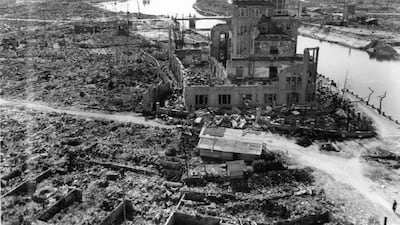The atom bombs dropped by the United States over the two Japanese cities of Hiroshima and Nagasaki in 1945 are defining disasters of mankind.
The Japanese people will never forget these bombings and, indeed, the world stands with them. While the death tolls reached 140,000 and 80,000 in Hiroshima and Nagasaki, respectively, and many more were injured, such devastation is etched in the memory not only due to its unprecedented destruction, but also because it confronted the reality that all mankind could be faced with annihilation.
Having never truly anticipated devastation on such a scale, even scientists who had been either directly or indirectly involved in the creation of the atom bomb expressed their regret. Albert Einstein, one of the world’s most renowned scientists, called for complete nuclear disarmament. Klaus Fuchs, a German-born physicist who was convicted of passing nuclear secrets to the former Soviet Union, said in his trial that his motivation was not money, it was the compunction that he felt for what scientists had inflicted on the human race by inventing nuclear weapons. Klaus believed that the only way to prevent its use was to break its monopoly by one state in order to create nuclear deterrence.
The debate continues regarding the reasons behind why the US decided to use atom bombs, especially considering that Japan was already leaning towards surrender.
However, it was clear that Harry Truman, then US president, was determined to use this new weapon, not only to force Japan into surrender but also to send a strong message to the Soviet Union and to declare the American leadership of the world.
Whatever the case may be, a new historical era was ushered in. This new era is characterised by four main features.
First, the atomic age has put an end to world wars, replacing them by small, proxy and cold wars. In the presence of nuclear weapons, it is no longer possible to launch a world war without their use.
Second, the emergence of a worldwide movement that calls for nuclear disarmament. The 1986 Treaty of the Non-Proliferation of Nuclear Weapons (NPT) was among the most notable outcomes of this movement. However, the NPT has not been effective, as evident with the increasing number of nuclear states – with some countries defying the treaty and acquiring nuclear weapons anyway, such as India, Pakistan, Israel and North Korea.
Third, despite the devastating impact of the Hiroshima and Nagasaki bombings, countries do not seem to have been convinced to abandon their nuclear ambitions. Instead, there is a fierce competition among them to acquire nuclear weapons to bolster their stature and influence. This is mainly because of the insistence of the most powerful nations on keeping and developing their nuclear weapons, as well as the weakness of international legal frameworks to prevent proliferation.
Finally, the world faces the risk of annihilation not merely because of this race, but because nuclear weapons could fall into the hands of extremists or irrational ruling regimes who could make uncalculated decisions. Further, there is an opportunity for human error in which something could happen by those entrusted with controlling or supervising nuclear weapons.
Although nuclear weapons have not been used since 1945, the world has faced the threat of nuclear destruction several times in recent decades due to human errors. More details on this can be found in the study, titled Too Close for Comfort: Cases of Near Nuclear Use and Options for Policy, published by Chatham House in April 2014. It highlights 13 incidents caused by human error that had subsequently brought the world to the brink of nuclear abyss more than once.
One episode mentioned in the study is that in the 1970s, US president Jimmy Carter sent a suit for dry-cleaning with the secret nuclear-weapon launch codes in a pocket. The same thing happened in May 1981, with the former French president. Also, the aides of former Russian president Boris Yeltsin and his US counterpart were always worried about their bosses’ decisions to use nuclear weapons. Humanity has no option but to fight with full resolve for a world free of weapons of mass destruction.
According to the Stockholm International Peace Research Institute, the number of nuclear warheads in the world stood at 15,850 in 2015. Of this, 7,260 were in the United States and 7,500 in Russia. This suggests that the world has built the tools of its own destruction. One reckless decision, miscalculation, or an error can obliterate the entire human civilisation.
Given the current state of flux and chaos, it is more urgent than ever to prevent nuclear proliferation. This goal should be placed above narrow economic interests and the calculus of political rivalry between major world powers. Indeed, major powers have the greatest role to play in this regard, particularly the United States and Russia that have 90 per cent of the world’s nuclear stockpile.
Dr Jamal Sanad Al Suwaidi is the director general of the Emirates Center for Strategic Studies and Research

